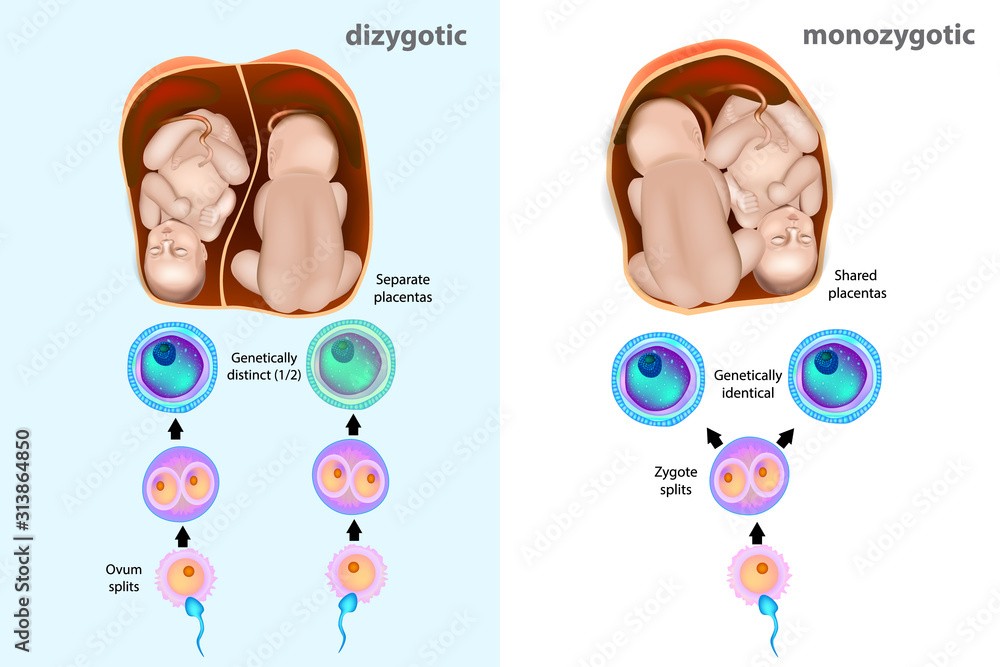
Contents
- 1 What Is the Difference Between Monozygotic Twins and Dizygotic Twins?
- 1.0.1 What are dizygotic twins?
- 1.0.2 Are monozygotic twins more similar than dizygotic twins?
- 1.0.3 How do you know if twins are monozygotic or dizygotic?
- 1.0.4 What determines monozygotic twins?
- 1.0.5 Do monozygotic twins have different DNA?
- 1.0.6 Can monozygotic twins be a boy or girl?
- 1.0.7 Can identical twins have two placentas?
- 1.0.8 Even with the same DNA, why do monozygotic twins look different?
What Is the Difference Between Monozygotic Twins and Dizygotic Twins?
Monozygotic twins, also known as identical twins, develop from a single fertilized egg (zygote) that divides into two embryos. Monozygotic siblings have the same genetic material and are mostly of the same sex.
Monozygotic twins have similar physical appearances because they share the same genetic traits.
Monozygotic twins are classified as the following:
- Dichorionic diamniotic (two distinct placentas and amniotic sacs)
- Monochorionic monoamniotic (one placenta and amniotic sac)
Monozygotic twins are uncommon, occurring three to four times out of every 1,000 births across all ethnic groups. Family history or other factors do not influence the likelihood of having monozygotic twins.
What are dizygotic twins?
Dizygotic twins, also known as fraternal twins, are formed when two separate eggs are fertilized by two separate sperm.
Dizygotic twins can be of the same sex or different sexes. As dizygotic twins do not always inherit the same genes, they may share physical traits to the same degree as other siblings. Additionally, dizygotic twins may have different placentas and amniotic sacs.
The incidence of dizygotic twins varies with ethnicity:
- 10 to 40 per 1000 births in Africans
- 7 to 10 per 1000 births in Americans and Europeans
- 3 per 1000 births in Asians
Maternal factors such as genetic history, advanced age, and higher parity increase the chances of dizygotic twins. Recent studies have reported that mothers with higher body mass indices and taller heights are more likely to have dizygotic twins.
Are monozygotic twins more similar than dizygotic twins?
The main difference between monozygotic and dizygotic twins is that the former have identical genetic makeup, whereas the latter do not. Monozygotic twins are identical in appearance and always of the same sex, but dizygotic twins can be of different sexes and differ physically.
An obvious physical variation, such as skin tone, facial features, or body build, may occasionally indicate that the twins are dizygotic. However, it may sometimes be challenging to differentiate whether twins are monozygotic or dizygotic based solely on their physical appearance.
Despite having the same genetic makeup, monozygotic twins can still have physical variations caused by factors such as environment, epigenetic modifications, and sporadic genetic mutations. Dizygotic twins can also resemble one another greatly, particularly if they are of the same sex and have similar genetic characteristics.
How do you know if twins are monozygotic or dizygotic?
To identify whether twins are monozygotic or dizygotic during pregnancy, it is best to use a combination of techniques, including genetic testing and inspection of the placenta and amniotic sac.
Factors that can distinguish between monozygotic and dizygotic twins include:
- Placenta
- Monozygotic twins can share a placenta or have separate placentas, depending on when the fertilized egg splits during development.
- Dizygotic twins mostly have separate placentas.
- Monozygotic twins can share an amniotic sac or have separate amniotic sacs, depending on when the fertilized egg splits during development.
- Dizygotic twins mostly have separate amniotic sacs.
- Monozygotic twins are primarily of the same sex because they come from the same fertilized egg.
- Dizygotic twins can be of the same or opposite sex, depending on whether two separate eggs were fertilized by two separate sperm.
- Monozygotic twins have nearly identical DNA, whereas dizygotic twins share about 50 percent of their DNA, like any other siblings.
- Genetic testing can determine the degree of similarity in the twins’ DNA.
- Monozygotic twins tend to look more alike than dizygotic twins on ultrasound images, especially in their facial features, as they share the same genetic traits.
What determines monozygotic twins?
Monozygotic twins are produced when a single fertilized egg divides into two embryos during embryonic development. The exact reason for this splitting is not entirely known but is thought to be a chance, random event.
- The exact time of the split can impact the number and kind of membranes and placentas that the twins share.
- The split can happen anywhere from a few days up to two weeks following fertilization.
Do monozygotic twins have different DNA?
Monozygotic twins are genetically identical or virtually similar and are formed when a single fertilized egg divides into two embryos during early development. This implies that they share the same genetic makeup and DNA sequence.
However, somatic mutations that happen during embryonic development or throughout a person’s lifespan, such as epigenetic modifications, can cause modest variations in the DNA of monozygotic twins.
These variations are uncommon and typically not significant enough to genetically separate one twin from the other.
Can monozygotic twins be a boy or girl?
As monozygotic twins originate from a single fertilized egg that divides into two identical embryos during early development, 99.9 percent of all monozygotic twins are always the same sex.
Both developing embryos will have the same sex chromosomes because the sex of the embryo is determined at the time of fertilization. Thus, monozygotic twins always share the same genetic makeup and are of the same sex.
However, in sporadic cases, male/female identical twins may develop from an egg and sperm. The genetic makeup of a man is XY and that of a woman is XX. During embryonic development, if the fertilized egg loses one copy of the Y chromosome during the division of the egg, then the offspring will be a pair of male (XY) and female (XO) twins.
A female’s chromosomal makeup is typically XX. Although an XO baby appears female, her cells contain just one copy of the X chromosome. This condition is referred to as Turner Syndrome.
Can identical twins have two placentas?
Depending on the stage of development at which the fertilized egg divides, identical twins can have two placentas.
- Dichorionic-diamniotic twins are produced when an egg splits within the first three days of fertilization, each developing its own placenta and amniotic sac.
- Monochorionic-diamniotic twins are developed when an egg separates between days 4 and 8 following fertilization, each having its amniotic sac but both sharing a placenta.
- Monochorionic-monoamniotic twins result from an egg splitting after day 8, as the embryos share a placenta and an amniotic sac.
Although it is more common for monozygotic twins to share a single placenta, they can also have two different placentas depending on when the fertilized egg separates. Genetic testing is the most reliable approach to establish whether twins are identical or fraternal.
Even with the same DNA, why do monozygotic twins look different?
Although monozygotic twins share the same DNA, they can still look different due to various factors that can influence gene expression and development, such as:
- Epigenetic modifications
- Can alter how genes are expressed without changing the underlying DNA sequence.
- Can be influenced by environmental and behavioral factors.
- This can result in different gene expressions that cause differences in the physical appearance of monozygotic twins.
- These are genetic changes that occur after fertilization during embryonic development or later in life.
- May alter how genes are expressed or how proteins function, resulting in variations in how people look.
- The way the fertilized egg divides into two embryos can differ slightly, resulting in variances in the amount and distribution of cells in each twin. This may cause the physical features of the two twins to differ.


